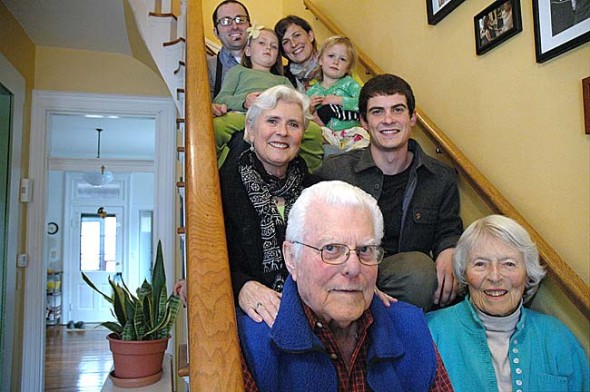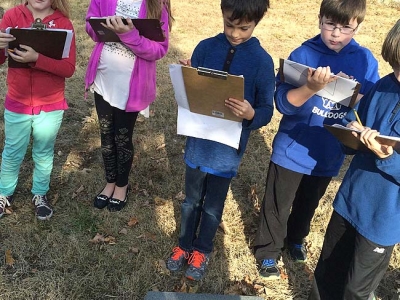
Wally and Evelyn Sikes, foreground, moved to Yellow Springs in the 1950s to live and work in the community. Their children and grandchildren grew up in the village, and though the third generation has returned to raise their own children here, finding local jobs is not as easy as it once was. Pictured behind the elder couple are Linda Sikes and her son Kevin Sikes-Gilbert, as well as her daughter Naomi and son-in-law Chris Bongorno with their children, from left, Nora and Elise. (Photo by Megan Bachman)
Coming home, but not for the jobs
- Published: March 27, 2014
Click to view all the articles in this series.
EYE ON OUR ECONOMY This is the second in a series of articles examining the economic landscape of Yellow Springs.
The high point of the Yellow Springs economy, like that of much of the rest of the nation, seems to have been during the post-World War II boom years of the 1950s and 60s. The town’s four small industries — Morris Bean, Vernay, YSI and Antioch Bookplate — employed hundreds of workers each, Antioch College was going strong, and small research firms — the Fels Lab and Kettering Research Institute, among others — fed off the college’s intellectual vitality. It was a time when young men like Wally Sikes and Tony Bent moved to the village for a job.
“It was easy to get a good job. There were lots of opportunities after World War II,” said Sikes, who came to Yellow Springs in 1949 to work in the Antioch College co-op department.
Both men brought their wives and settled in town, where they began raising families. It was a lively, vibrant time in the village, according to Sikes.
“It was great for young married couples here. There were lots of them,” Sikes said. “There were parties every week. If we didn’t go to a party on Saturday night, we felt deprived.”
More than five decades later, things have changed. Morris Bean, once the village’s largest employer with more than 500 workers, now employs around 100, and Vernay went from more than 400 employees to a handful, after moving its manufacturing plant to the south. Antioch Bookplate, also once a large employer, gradually diminished, and then decamped entirely, as Creative Memories, to St. Cloud, Minn. Antioch College, after closing several years ago, has been reborn and is growing, but at a slow pace. Only YSI, now a part of ITT’s Xylem, continues to thrive.
Most people who move to the village no longer come for a job. And yet they still come.
Wally Sikes knows this well. His granddaughter, Naomi Sikes Bongorno, is one of a close-knit group of YSHS Class of 1995 friends who in recent years have moved back to the village to raise their families.
“Although it’s different now, it’s still a vibrant town,” Sikes said.
The young women had all moved away for many years and began looking homeward only after they started families.
“I had such a good sense of community when I was growing up, and Yellow Springs is like no other place I’ve found,” Hilary Peirson, formerly Hilary Skea Lee, said. “I want that for my children, and for them to learn the values I learned growing up here.”
Moving back to the village offered considerable challenges to all four families, especially in terms of finding local jobs. All of the women’s husbands did eventually find work — three of the four women are stay-at-home moms, for now. But none of the jobs are in Yellow Springs, and they all require commuting or the ability to work from home electronically.
Still, all four families made the move they dreamed about, so that their children could have the sort of small-town childhood that they themselves enjoyed.
“It took a lot of hard work and a little bit of magic,” Peirson said, of moving back to Yellow Springs.
The golden age
In the early 1920s, Yellow Springs was a sleepy town with “an ancient sawmill, a nearly defunct canning plant, a grain elevator and a nursery that propagated evergreens from cuttings” with a combined total of perhaps 20 employees, according to Industries for Small Communities by Arthur Morgan.
Enter Dayton-area engineer Morgan, the new president of the moribund Antioch College, a man of great talent and big ideas. And his biggest idea featured smallness, specifically the importance of small communities.
“Throughout human history and for a long period before that, the small community has been the chief means for transmitting such basic cultural traits as good will, neighborliness and mutual confidence, without which no society can thrive,” Morgan wrote in the book.
Morgan believed that Yellow Springs could be a laboratory on the benefits of small community living, but when he arrived in 1920 this particular small town needed jobs. And the jobs needed to come from small industries, Morgan believed, ones large enough to offer work to a variety of people but small enough that their leaders cared about the town in which they lived. So he set about creating such a town. At the college he set up the Antioch Industrial Research Laboratory, aimed at engineering research and development. One of the first scientists lured to the college was Sergius Vernet, who was interested in a new principle of thermostat design. Vernet’s work led to the creation of Vernay Laboratories, which went on to become the village’s largest employer.
The college was also instrumental in the development of Morris Bean, a foundry started by student Morris Bean; Yellow Springs Instrument, founded by Antioch alums Hardy Trolander and David Jones; and Antioch Bookplate Company, founded by Ernest Morgan (Arthur’s son).
These small industries and others — such as Nosker Engineering, Vie Design, Odiorne Advertising and Dewine and Hamma Farm Seeds — grew to provide about 800 jobs in the late 50s and 60s, and were critical to the community not just for opportunities for employment, but for a town’s overall vitality, Morgan believed.
“The securing and developing of community industries is not just a matter of getting factories located and under way,” Morgan wrote in Industries for Small Communities. “It means building a total life and environment in which interesting and competent people would like to participate.”
In Yellow Springs, Morgan’s ideas seemed to work. Throughout the 50s, 60s and 70s, local businesses buzzed right along, with several, such as Morris Bean and Vernay, which made automative components, riding the wave of the post-war boom of the automobile.
“It did seem as though small industry was thriving,” said Dr. Carl Hyde, who moved to town with his family in 1954 to start a medical practice. “Young people could stay in town to find jobs.”
And Morgan’s prediction that the leaders of small industry would engage with the community also panned out, as local CEOs gave time and energy for the betterment of the town.
“The leaders of the companies were involved with the village,” Bent said.
According to both Sikes and Bent, there was little social distance between the heads of companies and their workers, and the parties often included people from all walks of life.
“The CEOs lived like anyone else,” Sikes said. “There wasn’t that much distinction between how the leaders of Vernay and Morris Bean lived and their employees.”
It was a time, nationwide, when working class people saw their living standard rise, and in Yellow Springs, Vernay employees benefitted from union representation while Morris Bean, though not unionized, sought to provide wages comparable to those of UAW workers.
“In the early days of Vernay and Morris Bean all their officers were Yellow Springs people and they employed Yellow Springs people,” according to Bent, who came to the village in 1952, also to work at the college. “That was the golden age. So many people were involved in making the community better.”
And according to Sikes, “There wasn’t much focus on economic development, because until the 1970s, things just happened.”
But at the beginning of the 1970s, that robust economy began changing.
A January 1971 Yellow Springs News article sounded a warning that local industries were losing about 10 to 15 percent of their jobs. YSI was down to 145 from 160, Morris Bean had laid off about 100 of the 600 it employed in Yellow Springs and Cedarville, and Vernay had dropped from 315 to 260. The job loss, which mirrored that nationwide, was linked to a downturn in the automotive industry, the article stated.
The local economic shift also reflected troubles at Antioch College, where the radical fervor of the 60s and 70s had taken a toll, according to Dr. Hyde. After the strike of the early 1970s, negative publicity led to fewer students, and the college’s enrollment slide, which ended with the school’s closure in 2008, had begun.
“People quit coming to Antioch because it was not a well-run college,” Hyde said. “What happened in the town is reflected with what happened to the college.”
One way the loss of local jobs was felt by village families was that young people who went away to college were less likely to come back, according to Hyde.
And when the local leaders of local companies died or retired, replaced by leaders who no longer lived in the village, a huge change transpired, according to both Sikes and Bent. Those leaders were no longer engaged with the community, and not only their financial resources but their creativity and intellect no longer benefitted the town.
Sometime in the 1980s, Village leaders, worried about the economic downturn, began simple efforts to spark economic development.
While the economy in many American small towns thrived in the post war years, Yellow Springs was singularly vibrant, Sikes believes.
“It had to do with the smallness, the success of our industries, the diversity of the people and the college — without the college it wouldn’t be the same,” he said. “Living in Yellow Springs — it’s been a great ride.”
A new generation
Wally Sikes’ granddaughter, Naomi Sikes Bongorno, never expected to come back to Yellow Springs. Like others in her group of friends from the YSHS Class of 1995, she chose city life, moving first after college to New York City, then in Cleveland.
But after she and her husband, Chris, had their first child several years ago, Bongorno found herself longing for Yellow Springs. She and her husband had a good house in a good Cleveland neighborhood, but something wasn’t right.
“I couldn’t see a time when I’d be comfortable with Nora going out on her own,” Bongorno said recently. “I just couldn’t picture city life for my kids.”
Bongorno’s good friend Eden Robertson Matteson, living in Chicago with her husband and two children, was having similar thoughts. Her oldest, Eli, was getting ready for kindergarten and had been accepted in a highly-rated school. But his school had more than a thousand kids, and no playground.
“I started crying every time I thought about being a kindergartner in this massive building, and no recess,” she said. “I thought of Mills Lawn and the grassy lawn.”
Two other good friends, Corrie Van Ausdal and Hilary Peirson, were also starting families and having similar thoughts. Peirson, who lived in Cincinnati, wanted her children to grow up in a tight-knit community.
“I knew Naomi since she was a baby,” Peirson said. “Growing up, we not only went to school together, we swam, played T-ball, went to Friends Music Camp at the same time.”
Matteson, wanting to be closer during a family member’s illness, was the first to return, in 2011. Her husband, Kevin, an ecologist, had a post-doc position at the University of Illinois at Chicago, but his boss agreed that he could work electronically part of the time, much to the couple’s surprise. Then after they moved, he was offered a job at Miami University, to which he now commutes several days a week, almost three hours of driving each day.
Peirson and her husband were the next to move back to the village, but only after Ryan Peirson, a psychiatrist, was able to piece together a living from work at several area institutions, including Wright State University and Montgomery County.
The Bongorno family was the last to move back, a year ago. They ended up with a house significantly smaller than their previous home and Chris Borgorno has the longest commute: an urban planner, he still works in Cleveland, where he drives every other week.
While her grandfather’s generation came to Yellow Springs for a job, Naomi Bongorno and her friends have come despite not finding jobs here.
“We were willing to sacrifice a great deal to get here,” Hilary Peirson said.
And they’re not the only ones. Other high school classmates have returned to the village, and all the women know other young families who moved here recently to raise their children. Higher enrollments at Mills Lawn School over the past several years seem to indicate that this may be a trend.
But the women also know families who wanted to move here but ended up somewhere else. The obstacles are real: a lack of jobs and a lack of affordable housing top the list.
With the help of family, their own determination and a little bit of luck, these four women managed to reach their dream of raising their children in Yellow Springs. And while they gave up some things, they don’t look back. Their children have prospered, all said, and they themselves have found the sense of community they longed for. In the last few years they’ve been there for each other when parents died or faced major illness, when life sent the hard stuff their way.
“As you get older, having community means so much. We lose loved ones and death is more a part of our lives,” Peirson said. “There’s so much value in having good friends to share the happy and sad times.”
The phrase, “You can’t go home again” once gave her pause, Peirson said, but now she no longer worries that she’s chasing an unrealistic goal.
“You can go home again,” she said. “I have, and I have no regrets.”
The Yellow Springs News encourages respectful discussion of this article.
You must login to post a comment.
Don't have a login? Register for a free YSNews.com account.















No comments yet for this article.